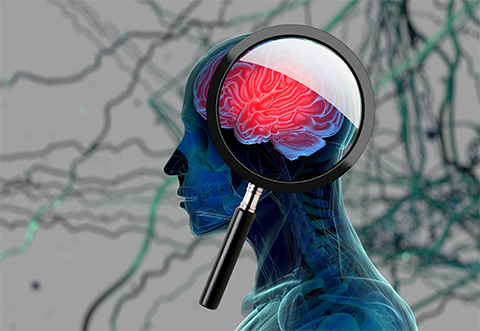From the journals: MCP
Targeting sANPEP in brain disease. A new insight for treating renal cancer. Read about articles on these topics recently published in the journal Molecular & Cellular Proteomics.
Targeting sANPEP in brain disease
Neuroinflammation, a response to cellular injury in the brain or spinal cord, helps the immune system and the brain communicate by recruiting cytokines and chemokines and also plays a role in neurodegenerative conditions such as Parkinson’s and Alzheimer’s diseases, multiple sclerosis and amyotrophic lateral sclerosis.

Complex integral activity among cells in the central nervous system, or CNS, including neurons and glia cells, causes neuroinflammation. The macroglial cells known as astrocytes, the most abundant and diverse nonneuronal cells in the CNS, are major regulators of neuroinflammation. Microglia, an integrative part of the CNS system, are nonneuronal cells that regulate the innate immune response of the brain. The crosstalk between microglia and astrocytes supports neuronal function and survival after acute CNS injury or disease, and this communication is maintained via secreted growth factors, cytokines, chemokines and innate-immunity mediators.
A recent Molecular & Cellular Proteomics article by Jong-Heon Kim and a team from Korea and the U.S. focuses on how the brain renin–angiotensin system, or RAS, regulates the astrocyte–microglia crosstalk by analysing the astrocyte secretome, which provides information about secreted proteins and their pathways.
The researchers identified a markedly elevated level of a soluble form of aminopeptidase N called sANPEP, a RAS component in the secretome, during neuroinflammation. They identified 322 proteins by proteomic analysis in astrocyte-conditioned medium following inflammatory stimulation. When they analyzed the proteins’ functional distribution, they found sANPEP was one of the upregulated proteins in RAS that is related to inflammation-associated pathways in activated astrocytes. They also found a significantly higher sANPEP level in the plasma of mice genetically altered for neuroinflammation than in unaltered mice.
This work helps identify sANPEP as a biomarker in disorders such as Alzheimer’s disease, because it is upregulated in the body fluid and human astrocytes in a neuroinflammation model. Its enzymatic activity to promote microglial stimulation indicates therapeutic potential as a drug target.
An insight for treating renal cancer
About 5% to 10% of all known cancer types are hereditary. These cancers, linked to gene mutations passed from parents to their offspring, are often difficult to treat.
Birt–Hogg–Dubé, or BHD, syndrome, a rare autosomal dominant inherited disorder, often precedes development of renal cell carcinoma, or RCC. In 2002, researchers identified a germline mutation in the folliculin gene, or FLCN, as a factor for BHD development. Since this discovery, multiple research groups have tried to understand how FLCN functions in RCC.
In a recently published Molecular & Cellular Proteomics article, Iris Glykofridis and a team in the Netherlands delved into the phosphorylated kinase pathway to understand how FLCN suppresses renal tumorigenesis. They investigated the role of FLCN in the cellular signaling pathway via protein and receptor phosphorylation by analyzing phosphoproteomic profiles of human renal tubular epithelial cells with and without FLCN. They identified specific tyrosine phosphorylation sites with markedly higher levels of phosphorylation in major receptor tyrosine kinases like EGFR and significant dephosphorylation in transcription factor EB phosphoserines upon FLCN loss.
The researchers analyzed the phosphoproteomic data and showed that FLCN loss has a clear effect on the phosphorylation of kinases and substrates within multiple biological pathways and may be important for the onset of oncogenic transformation of renal cells. The authors hope that understanding the FLCN-dependent phosphorylation pathway can open a new window to help design novel candidates for targeted therapies.
Enjoy reading ASBMB Today?
Become a member to receive the print edition four times a year and the digital edition monthly.
Learn moreGet the latest from ASBMB Today
Enter your email address, and we’ll send you a weekly email with recent articles, interviews and more.
Latest in Science
Science highlights or most popular articles

CRISPR epigenome editor offers potential gene therapies
Scientists from the University of California, Berkeley, created a system to modify the methylation patterns in neurons. They presented their findings at ASBMB 2025.

Finding a symphony among complex molecules
MOSAIC scholar Stanna Dorn uses total synthesis to recreate rare bacterial natural products with potential therapeutic applications.

E-cigarettes drive irreversible lung damage via free radicals
E-cigarettes are often thought to be safer because they lack many of the carcinogens found in tobacco cigarettes. However, scientists recently found that exposure to e-cigarette vapor can cause severe, irreversible lung damage.

Using DNA barcodes to capture local biodiversity
Undergraduate at the University of California, Santa Barbara, leads citizen science initiative to engage the public in DNA barcoding to catalog local biodiversity, fostering community involvement in science.

Targeting Toxoplasma parasites and their protein accomplices
Researchers identify that a Toxoplasma gondii enzyme drives parasite's survival. Read more about this recent study from the Journal of Lipid Research.

Scavenger protein receptor aids the transport of lipoproteins
Scientists elucidated how two major splice variants of scavenger receptors affect cellular localization in endothelial cells. Read more about this recent study from the Journal of Lipid Research.

